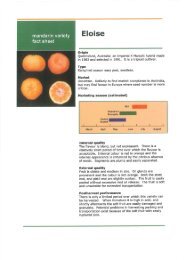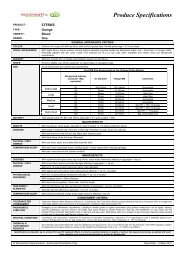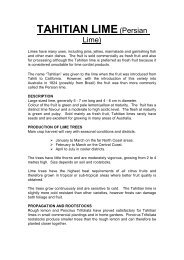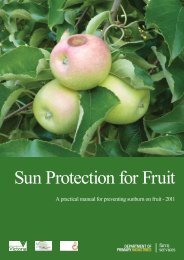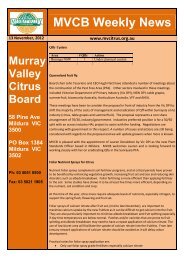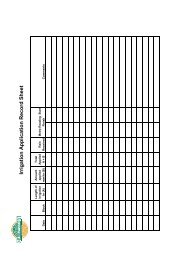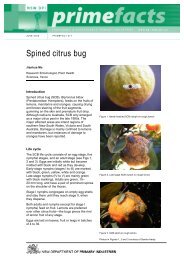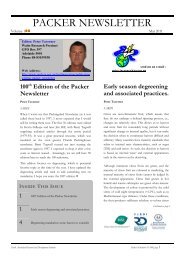Citrep #70 December 2012 - Murray Valley Citrus Board
Citrep #70 December 2012 - Murray Valley Citrus Board
Citrep #70 December 2012 - Murray Valley Citrus Board
You also want an ePaper? Increase the reach of your titles
YUMPU automatically turns print PDFs into web optimized ePapers that Google loves.
14<br />
Newsletter of the <strong>Murray</strong> <strong>Valley</strong> <strong>Citrus</strong> <strong>Board</strong><br />
Sunraysia <strong>Citrus</strong> Growers Inc. - Chairman’s Report <strong>2012</strong><br />
The past year has again been a testing one for citrus growers in the <strong>Murray</strong> <strong>Valley</strong> and throughout<br />
Australia. The continuing and sustained rise of the Australian Dollar has made it difficult to<br />
service many of our existing markets for a profitable return.<br />
In turn this has led to a continued<br />
oversupply on domestic markets and<br />
a glut in domestic juice demand. It is<br />
disappointing that something out of our<br />
control (the high dollar) continues to cast<br />
a shadow over our industry and all other<br />
producers and manufacturers in Australia.<br />
The quality of fruit in the past season has<br />
been exceptional and ironically, higher<br />
quality packouts have led to increased<br />
marketing pressure.<br />
Perhaps a highlight of the past year has<br />
been the increased volume of fruit being<br />
sent to China. This market has shown<br />
significant growth at sustained prices.<br />
Continued work to improve protocols will<br />
further increase the volume of fruit to<br />
both China and Korea into the future.<br />
On a more disappointing note, this year<br />
also saw the introduction of the Carbon<br />
Tax. The full impact of this tax is yet to<br />
be quantified, but costs such as electricity<br />
(and water delivery) transport and<br />
refrigerant gas will all increase.<br />
With the State governments in both<br />
Victoria and NSW balancing shaky<br />
budgets, the past year has seen reductions<br />
in funding and job cuts at DPI and the<br />
closure of the Lower <strong>Murray</strong> Darling CMA<br />
in NSW. Research and Development has<br />
long been at the heart of our industry<br />
and it will be important for us to fight<br />
to maintain the capacity at the Dareton<br />
Research Station.<br />
This year saw growers in the <strong>Murray</strong> <strong>Valley</strong><br />
vote in favour of an order to continue<br />
the operation of the <strong>Murray</strong> <strong>Valley</strong> <strong>Citrus</strong><br />
<strong>Board</strong>. The clear mandate given to the<br />
MVCB highlighted the importance of a<br />
regional presence in Sunraysia. Whilst<br />
there was heated debate during the vote,<br />
SCG hopes that it can work with both<br />
the MVCB and <strong>Citrus</strong> Australia to achieve<br />
profit generating outcomes for growers at<br />
a regional, national and international level.<br />
SCG has the history, membership structure<br />
and financial capacity to continue as<br />
the agri-political representative body for<br />
citrus growers in our region. SCG opposes<br />
the introduction of any new Regional<br />
Advisory Committee in Sunraysia as it is<br />
unnecessary and would not be beneficial<br />
to growers.<br />
In my last Chairman’s Report (2011)<br />
I wrote “Whilst Minister Walsh has<br />
expressed his commitment to the QFF<br />
problem, we are yet to see any real<br />
measures to overcome the problem. It<br />
appears that both the NSW and VIC<br />
Governments are unwilling to commit<br />
funds to the issue and there is an<br />
increasing risk that they may walk away<br />
from the problem.”<br />
Fruit Fly management continues to be a<br />
major problem for <strong>Citrus</strong> producers in the<br />
Sunraysia PFA. It is disappointing that<br />
both State Governments have now reduced<br />
their efforts against QFF due to budget<br />
constraints. In the case of Victoria, the<br />
Government is now looking for an industry<br />
contribution of 70% to maintain the<br />
PFA. The MVCB along with other industry<br />
groups are continuing negotiations to<br />
achieve the best outcome for growers. We<br />
can only hope that fewer fly trappings at<br />
present will make it easier to manage the<br />
problem and allow us to get back to area<br />
freedom for the 2013 season.<br />
The circus that is the Basin Plan continues,<br />
with the Government still looking to have<br />
something through parliament this year.<br />
The SDL number has now been increased<br />
by 450GL to 3200GL in a measure to<br />
appease South Australia. The extra<br />
450GL is to come from savings from<br />
infrastructure projects. There is still no<br />
consensus amongst the states and it would<br />
appear that there is a lot of water to go<br />
under the bridge before 2019. All this, at<br />
a time when the storages are at record<br />
levels and Dartmouth is about to spill for<br />
only the third time ever. If only all those<br />
consultants fees could have been spent on<br />
digging another dam!<br />
SCG has maintained its membership of<br />
the National Irrigators Council (NIC) and<br />
receives weekly updates on the political<br />
happenings surrounding the plan. The<br />
NIC is the most recognised irrigator lobby<br />
group and enjoys significant political and<br />
media access.<br />
In the last few months, the Directors of<br />
SCG have contributed money towards<br />
the production of a documentary called<br />
“Muddied Waters a Clear Solution”.<br />
The project consists of a documentary,<br />
interactive website and educational<br />
strategy to promote smarter solutions that<br />
will change minds and change policy.<br />
The documentary will be finalised in early<br />
<strong>December</strong> and will air on commercial<br />
television shortly after. One of the key<br />
elements of the project is to focus on the<br />
importance of irrigation and food and fibre<br />
production in the basin. The project aims<br />
to counter the “Green” views that have<br />
become mainstream and often against<br />
the truth and at the expense of basin<br />
communities.<br />
SCG will be looking for some fresh<br />
direction in the next financial year and<br />
will be looking to appoint some new<br />
Directors to fill existing vacancies. All<br />
members are encouraged to consider<br />
joining the <strong>Board</strong> and sharing their<br />
industry views. The time commitment<br />
required of Directors is not onerous and<br />
we would particularly welcome member<br />
representation from the Nangiloc region.<br />
The SCG Directors have met with building<br />
contractors and are awaiting some design<br />
concepts and costings. The work to be<br />
undertaken during the next year will<br />
include exterior painting, modernising the<br />
front of the building and repairs to the<br />
back fences. Once the work is completed,<br />
the Directors will look at the potential for<br />
refreshed promotional advertising on the<br />
external walls.<br />
A net surplus of $36,069 was achieved for<br />
the year ending 30 June <strong>2012</strong> compared<br />
to the previous year’s surplus of $21,346<br />
(2011). Levy income for the 11/12 season<br />
was $29,208, an increase of 50%. This<br />
change was due to the exceptionally light<br />
crop of 2010 being followed by the very<br />
heavy crop of 2011. The administrative<br />
costs of maintaining SCG have been<br />
significantly reduced over the past two<br />
years and surplus funds are being invested<br />
in bank term deposits.




